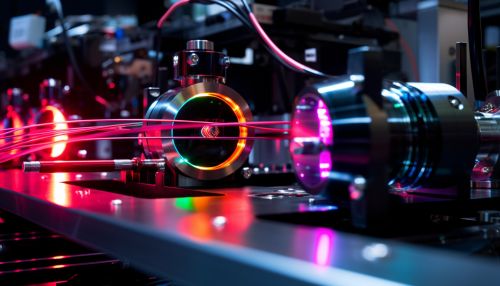Quantum Computing with Quantum Optomechanical Systems in the Study of Quantum Physics
Introduction
Quantum computing is a rapidly evolving field that leverages the principles of quantum mechanics to perform computational tasks. One of the promising approaches in this field is the use of quantum optomechanical systems, which combine the properties of light (optics) and mechanical motion at the quantum level. This article explores the role and significance of quantum optomechanical systems in the study of quantum physics and quantum computing.


Quantum Optomechanical Systems
Quantum optomechanical systems are physical systems that allow for the interaction of light with mechanical motion in the quantum regime. These systems are typically composed of a mechanical oscillator, such as a tiny mirror or a vibrating membrane, coupled to an optical cavity that confines light. The interaction between the mechanical oscillator and the light field can lead to a variety of interesting quantum phenomena, such as quantum entanglement and quantum superposition.
Quantum Computing
Quantum computing is a paradigm of computation that utilizes the principles of quantum mechanics to process information. Unlike classical computers, which use bits as their fundamental units of information, quantum computers use quantum bits, or qubits. Qubits can exist in a superposition of states, allowing quantum computers to perform many computations simultaneously. This parallelism can potentially provide quantum computers with a significant computational advantage over classical computers for certain tasks.
Quantum Optomechanical Systems in Quantum Computing
Quantum optomechanical systems can be used in quantum computing in several ways. One of the most promising applications is the use of these systems for the implementation of quantum gates, the basic building blocks of a quantum computer. Quantum gates operate on qubits, changing their state in a way that depends on the principles of quantum mechanics.
Furthermore, quantum optomechanical systems can also be used for quantum error correction, a crucial aspect of quantum computing. Quantum error correction is necessary to protect the fragile quantum states of qubits from errors due to environmental noise and other sources of decoherence.
Quantum Physics and Quantum Optomechanical Systems
Quantum optomechanical systems provide a powerful platform for exploring various aspects of quantum physics. For instance, they can be used to study quantum entanglement, a phenomenon in which the states of two or more particles become intertwined such that the state of one particle cannot be described independently of the state of the other particles.
Moreover, quantum optomechanical systems can be used to probe the boundary between the quantum and classical worlds. For example, they can be used to investigate the quantum-to-classical transition and to test the validity of quantum mechanics at macroscopic scales.
Conclusion
Quantum optomechanical systems play a pivotal role in the study of quantum physics and the development of quantum computing. They provide a versatile platform for implementing quantum gates, performing quantum error correction, and exploring fundamental aspects of quantum mechanics. As our understanding of these systems continues to deepen, they are likely to play an increasingly important role in the advancement of quantum technologies.
